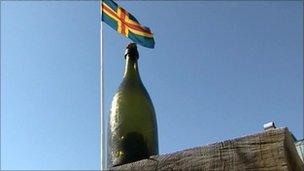'World's oldest champagne' found on Baltic seabed
- Published
"It was an honour to drink it"
Divers have found 30 bottles of champagne thought to pre-date the French Revolution on the Baltic seabed.
When they opened one, they found the wine - believed to have been made by Clicquot (now Veuve Clicquot) between 1782 and 1788 - was still in good condition.
The bottle - whose shape indicates it was produced in the 18th Century - has now been sent to France for analysis.
If confirmed, it would be the oldest drinkable champagne in the world.
Diver Christian Ekstrom was exploring a shipwreck on the Baltic seabed when he found the bottles.
'Sweet taste'
He took one to the surface, where he opened it and tasted it with his colleagues.
"It was fantastic," he told the Reuters news agency.
"It had a very sweet taste, you could taste oak and it had a very strong tobacco smell. And there were very small bubbles."
According to records, Clicquot champagne was first produced in 1772 but was laid down for 10 years, the French news agency AFP reported.

Experts think the remaining bottles could fetch high prices at auction
Production was disrupted after the French Revolution in 1789.
The wine found on the seabed was perfectly preserved because of the conditions of dark and cold on the seabed.
If the bottles do come from the 1780s, that would make them around 40 years older than the current record-holder, a bottle of Perrier-Jouet from 1825.
Wine experts estimate each bottle would fetch around 500,000 Swedish kronor (£45,000; $69,000) at auction.
The bottles were found off the coast of Aaland, an autonomous part of Finland. The local authorities will decide what is done with the shipwreck - and the champagne.